Table of Contents
What This Twitter Guide is All About
To start with, I’d like to state that there is no right or wrong way to do Twitter. What I’m sharing today are my personal workflow, preferences, and perspectives. You or others may or may not agree with all of these methods, but this is how I like to run my own account, and what works best for the moment. To date A Chronic Voice has about 15,000 followers on Twitter, but it took three years of hard work to get here. I also didn’t get here on my own, it always takes two hands to clap on social media!
Last Updated: 03 April 2020
Why I Love Twitter
If you hadn’t already figured it out, Twitter is my favourite social media platform for many reasons. I find it to be a good mix of user engagement and genuine content. I am able to share my posts with any and everybody, it’s pretty impartial like that. And it’s especially great for wordy content, memes, polls, and cute inline videos. In fact, I found all my favourite blogs and people through Twitter.
There are content that I would have taken ages to hunt down, if I were using any other search engine including Google. Twitter is a powerhouse search engine that resounds with authentic human voices. If you’re looking for real people with a spectrum of perspectives, Twitter is the place to go.
Getting Started on Twitter
As with anything else, it can feel overwhelming in the beginning, especially with the fast pace and high volume of Twitter. But after you get the hang of it and work out a rhythm for yourself, it can actually be an enjoyable experience. I get over a hundred notifications in a day, yet I find it exciting more than draining.
To reap the benefits of this human powered search engine, you first need to know your way around. In this article you will learn how to organise your information, look for what you need, and grow your account in healthy ways.
Tip 1: Good Old-Fashioned Manners are Everything
This shouldn’t have to be said, but interactions from behind a cold screen have desensitised us toward other human beings. If someone has taken the time and effort to share your tweet or to give you a shoutout, say thank you. It really isn’t that hard to do. Can you imagine being that rude in real life?
There are a few ways to show your gratitude. It’s a little like ‘picking your own poison’ because there are pros and cons to each. I personally try to thank everyone who retweets posts from my blog. For those who have liked any of my tweets, I try to return the favour as well.
I admit to being a bit of a serial ‘liker’, as I think it’s such a simple way to spread some love online. It also helps to open up communication pathways, which can be a barrier with the lack of physical presence. There’s the other camp who is more conservative with their likes, and that’s good as well. (More about this below!)
Takeaway: While it isn’t an obligation to say thank you, it’s nice to show some gratitude and community spirit.
Tip 2: Take the Lead. Show an Interest in Others First.
Sure, we all want our content to go as far and wide as possible, but if we want others to care, then we need to take that first step. There are so many good writers and content creators out there, so why would what you have to say be more important? Let your personality cut through all that noise online. Reply to comments, share articles that resonate with you, aim to get to know your followers better.
I personally aim to be as open-minded as possible, and try to listen to all (constructive) perspectives. I don’t care if you’re a Republican or Democrat (but then again, I’m not American 🙂 ) – you are still a human being. For all you know, something you share may touch an unlikely candidate’s heart, whether they publicly ‘like’ it or not. I also believe that to raise awareness and to be an advocate is to put yourself out there – to be vulnerable and accessible. The people who need to understand certain concepts the most, may ironically be the ones you’re blocking.
Takeaway: Take a genuine interest in the lives of people behind the tweets.
Tip 3: Sharing Posts for Maximum Impact
Have you ever clicked on a link, only to find that it doesn’t lead you to that article promised in the headline? What this may reflect is that the person who retweeted it, didn’t actually click on the link themselves. I like to share excerpts from articles I’ve read, as opposed to just hitting the ‘retweet’ button. Usually the title of the post is used, and often that doesn’t give the reader enough incentive to click on the link. Take a look at these examples, which would you click on?:
“Latest Life Updates”
vs
“Life has been punching me in the face of late. But this one little reminder helped me to get back up, and throw some punches back myself.”
“Twitter Tips”
vs
“Have you always been curious about Twitter, and want to learn how to reap maximum benefits from this powerhouse search engine? Find out how to do so here.”
Doing this adds a subconscious stamp of verification that the post might be worth checking out. People are also generally interested to know what you found most thought-provoking – think Kindle or Medium top highlights.
Other Benefits of Quoting Articles
Quoting the article also pays a huge compliment to the author. To know that someone took the time to read your words can feel amazing, and tells them that it’s a job well done. Don’t forget to include the author’s handle in your tweet; apart from alerting them, it is also an opportunity for potential friendships and conversations. I know I still get excited whenever one of my posts gets a retweet 🙂 Bloggers – please make your social media handles easy to find on your websites. It’s highly beneficial to you as well!
Finally, a practical reason for quoting articles is that your handle gets included in all subsequent retweets. Your handle represents your ‘brand’, and the extra mileage on each tweet can go a long way.
Takeaway: Share excerpts from posts for the benefits of verification, extra mileage and potential community building.
Tip 4: Use a Scheduling App to Hit Sweet Spots Across Time Zones
I use Buffer to schedule 15 tweets a day on average (18 on the weekends to help clear the queue!). There are a few good reasons to spread your tweets out. For one it would be spammy to dump them all onto your feed back to back. The deluge of tweets on your followers’ feed can be overwhelming, and lead to an annoyed unfollow.
Besides that, the online world is one that never sleeps, so you shouldn’t confine tweets to your timetable. The peak period in your corner of the world is not applicable worldwide. Even if your aim is to hit a certain group of people in a specific timezone only, there’s an upside to posting during the quieter hours as well. Whilst posts during peak hours have a wider outreach potential, downtimes equal to less competition and therefore, more eyeballs per tweet.
After quite a bit of experimentation, I have nailed down 3 – 4 ‘sweet spots’ for my own content, spread out over 24 hours. There isn’t much use sharing these timings because they are dependent on so many factors, and is something you need to discover for yourself. The industry, your main audience’s timezone, lifestyle, working hours, family time, etc.
Takeaway: Take some time to figure out the sweet spots for your tweets, in a world that never sleeps.
Tip 5: Yes it’s Okay to Tweet the Same Thing More Than Once
In the beginning I was afraid that posting the same thing more than once might be spammy and annoying. Then I read this useful article from Buffer, which helped me to get started with my own Twitter plans. I realised that Twitter is a high volume platform, meaning many tweets get lost or left behind along the way. People who actually want to read your content may not even have had the chance to see it appear on their feeds.
My strategy is pretty much like the one suggested in the article; I schedule three different excerpts from the same blog post over two days, during my prime hours. Next I save a few more excerpts that might be of interest to my readers, and schedule them during downtimes after a week, a month, then two months.
This doesn’t only include my own blog posts, but extends to other blogs that have proven to be good reads as well, albeit on a lesser scale. These can add up fast, so I have a Google calendar to help me keep track and organise them. Your own strategy can be whatever you want it to be, but that’s mine for the moment!
Takeaway: Formulate a strategy for scheduling your tweets beyond the here and now. Reach out over 24 hours, even weeks and months after.
Tip 6: People Like New Things, and They Don’t Like to Feel Cheated
I always make it a point to let others know that it’s fresh off the press, whenever I share a new blog post. I can’t remember where I read this tip from, but it did make a difference after I implemented it. People like new things, and they want to know it isn’t something they’ve read before.
Compared to other social media platforms, Twitter is extremely fast-paced. ‘Should I click on this?’ That tiny fraction of a second needed to make a decision can be fatiguing when done on repeat. People are overloaded with information and reiterations online. So help them make that decision by leaving no room for question.
I also like to add an ‘archive’ or ‘updated’ tag to posts from the past, depending on the number of changes I’ve made. This gives my readers immediate clarity. They can make their own decision on whether to re-read it, as a reminder or for deeper insight. I tend to feel a little cheated when I click on a link expecting to read something new, only to discover that it’s just repackaging. Surprisingly, I don’t get this feeling if the writer states this upfront. Once again, I’m simply sharing my thoughts. You don’t have to follow me on this one, but I’m curious to know if anyone else gets the same reaction?
Takeaway: Decision fatigue is real. Remove as many barriers as possible. Help users decide to click on your link.
Tip 7: #Hashtags are the Bread and Butter of Twitter
It’s important to take some time to explore which hashtags are popular in your industry, and what your target audience likes to use. You can gain some insight by doing a search for common phrases, and taking a look at hashtags under the Popular tab. For example, I would do a search for ‘chronic illness’ or ‘mental health’.
Within each niche there are also some unique hashtags that you might not have even known existed. For example, people with chronic illnesses are known as #spoonies in the online world, and there’s a #SpoonieProblems hashtag where they share about the (painful but often humourous) issues they face in their daily lives. (You can learn more about the ‘Spoon Theory’ here.)
How Many Hashtags Should I Use?
I generally use five hashtags per tweet, with a mix of generic and specific keywords. For example, #healthcare would be a fairly generic hashtag, and #ChronicLife would be something more specific. This helps me to reach out to different sets of audiences that fall under the same umbrella, and whom my content may be of interest to. My blog doesn’t only aim to help those with chronic illnesses, but also to raise awareness within the general public.
Other Hashtag Tips and Tricks
I’m not sure if anyone else does this, but I try not to repeat the same hashtags a few tweets in a row. For example, if I’ve just used #ChronicIllness in a tweet, then I use #InvisibleIllness or #spoonie in the next. This helps to spread my content out, as people may only search for one hashtag before closing their Twitter. Repeating the same hashtag over a short span of time can also appear spammy under the ‘Latest’ search tab.
Another good reason as to why you should use and search for the right hashtags, are the connections that are waiting for you out there. People who are facing similar situations often reply to random threads, offering solidarity. I would go so far as to say that this ability to find and build such communities is one of Twitter’s key strengths. Not even a quick Google search can accomplish that.
Takeaway: Spend some time learning what the best hashtags are for your industry. Use them both to reach out to your intended audience, and to build communities within your niche.
Tip 8: How to Power Up Your User Profile
Use Hashtags in Your Bio
Besides tweets, hashtags included in your profile description are searchable as well! It’s a good idea to include a few popular hashtags that you want to be associated with at all times. I use #Lupus and #AntiphospholidSyndrome, which are some illnesses I have and talk about on my blog.
Take a look at these examples, using #antiphospholipidSyndrome as a search term. My account is the only one utilising this hashtag in my user profile and therefore, the only one that’s showing for this topic under the blue ‘People’ tab. This is a rare occurrence for a high volume platform like Twitter. I am also listed under the ‘Top’ tab. Antiphospholipid Syndrome isn’t even a made up or rubbish term. It’s an actual autoimmune disorder, yet one that’s still rare within the chronic illness spectrum as well.
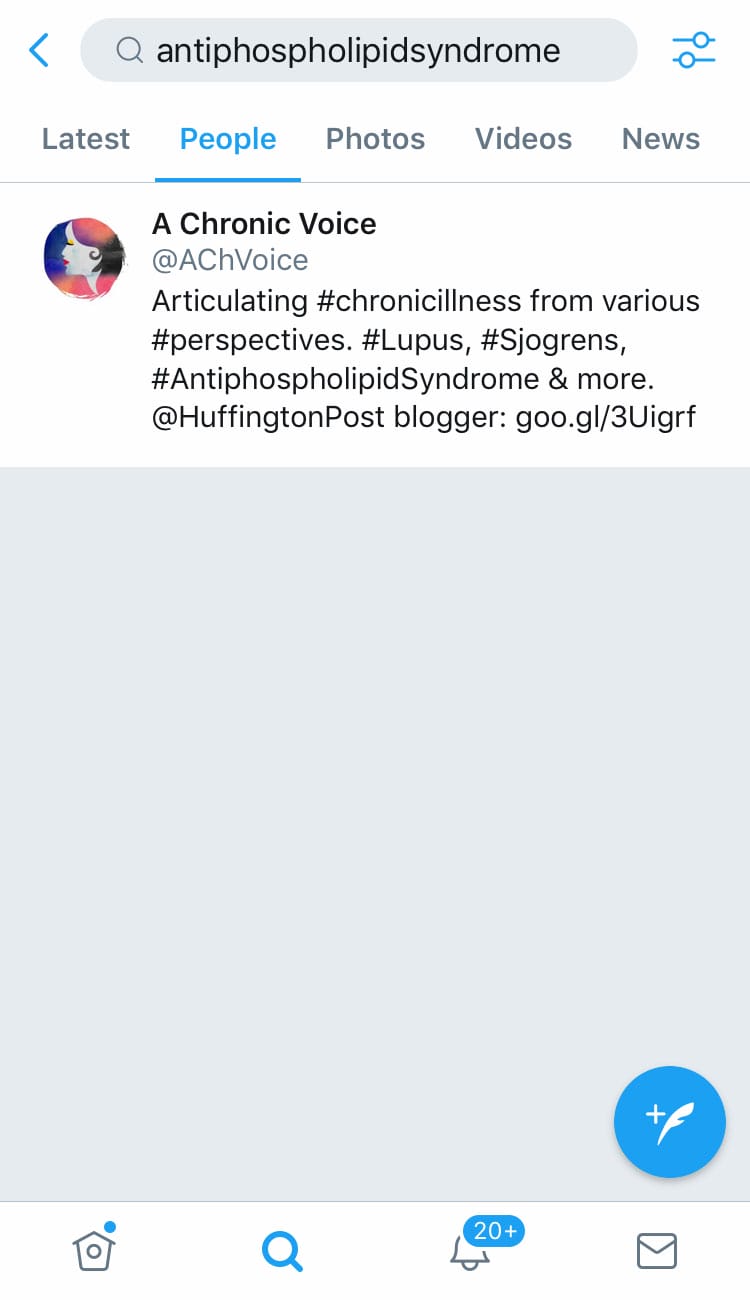
Now take a look at when I use the words ‘chronic illness’ as a search term instead. This is a broad spectrum search term, and therefore, goes at a much faster pace. It just happened that someone tweeted one of my articles when I took this screenshot, and is listed first under the ‘Top’ tweets tab. As you can see in the next image, the ‘Latest’ tweets are only a minute apart. This search term is more popular, so to speak. Meaning it has a wider audience, yet is also harder to pin down.
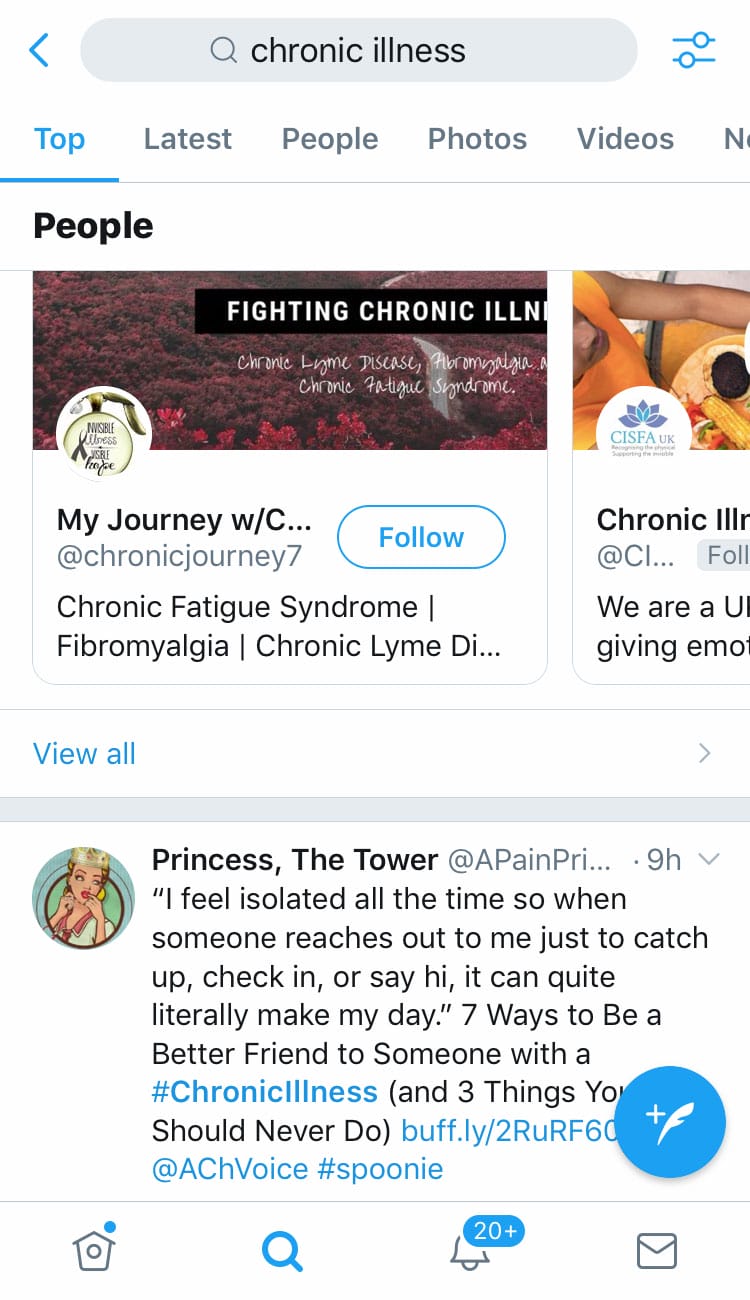
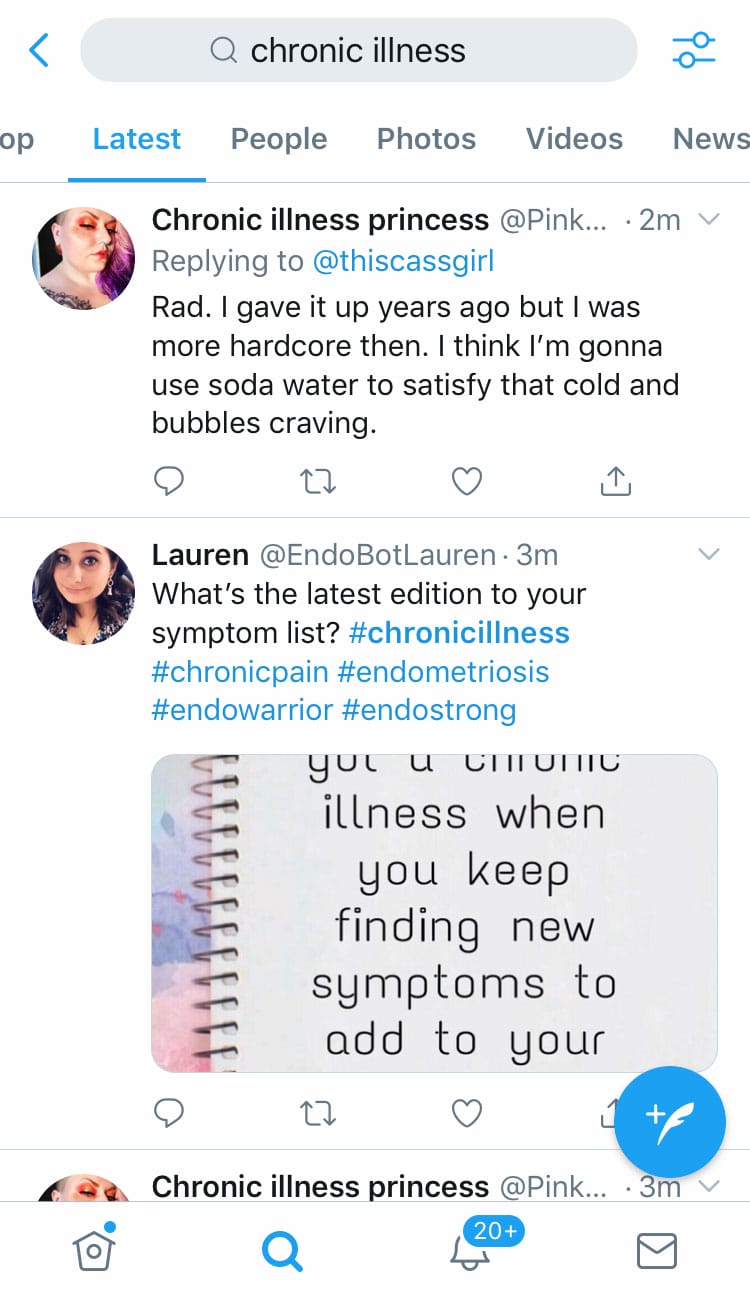
Consistent Identity Across Social Networks
Another (literally) small thing you should do is to use the same handle and image across all your social media profiles – Twitter, Instagram, Facebook, Pinterest, etc. This is your identity in a crowded online space, and you need to make it a point to stand out even if you’re a discreet person in real life, or your content will never be seen. You also want to be consistent and easily identifiable; now is not the time to be coy, it would only frustrate users online 😉
Make Your Thumbnail Stand Out
Every notification displays the thumbnail of the user or thread related to it. These thumbnails also show up as you type within search boxes. The problem is that they’re so tiny, that it can be hard to make out who or what they represent.
Those with bright colours or memorable images are the easiest to spot. Faces can often blur into each other, and I often need to do a double take to ensure that I’ve tagged the right person. You can do a few searches as a mini experiment to see what I mean. Then take what you find attractive and apply the concept to your own profile image.
Takeaway: Hashtags are not only for tweets, use them to your advantage in your profile description. Use an attractive profile image, so that users can identify you on sight, even in tiny thumbnail size!
Tip 9: Don’t Manually Select the Image in Your Scheduling App
When you enter a URL to schedule within Buffer, images from the website are pulled up and displayed. You can click on one or a few of them to use as image cards for your tweet. At first I thought that this was a brilliant idea, because a full width image card on users’ feeds would be more eye-catching, right?
Then I figured that it was even better to not select any image at all. The tweet then displays the main image and meta description (if there’s enough screen space), which is helpful on a platform where words are premium property. There is a 280 character limit on Twitter so every single letter (not even word!) counts. The meta description provides readers with extra insight to the post’s content – think of it as free, bonus characters to your tweet. If you are a blogger, take some time to come up with an insightful meta description for this very purpose.
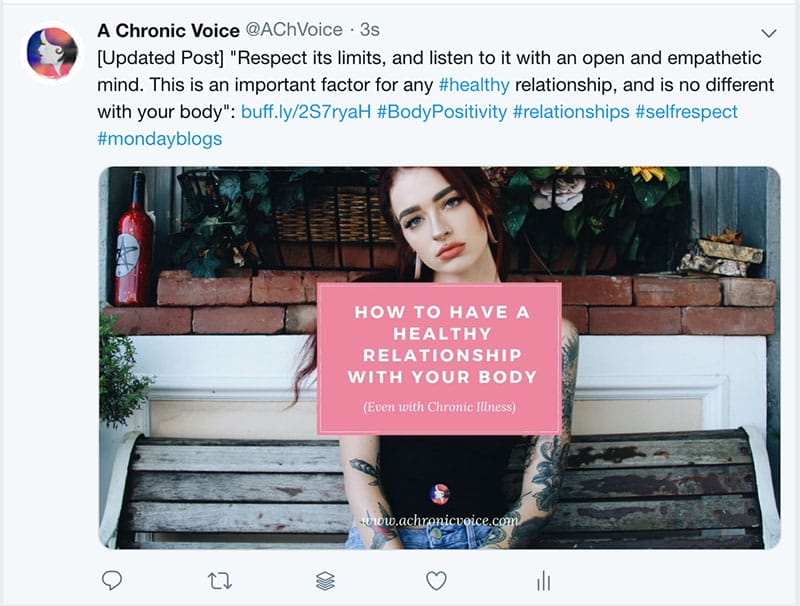
I manually selected an image in my scheduling app here.
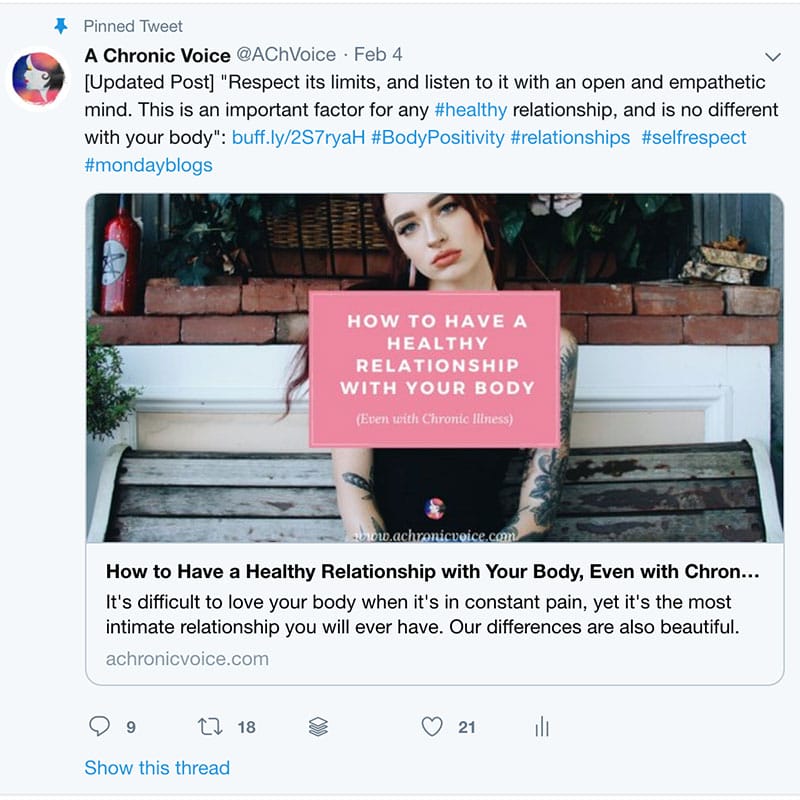
I did not select an image in my scheduling app here. This allows the meta image,
title and description to automatically show up in my tweet.
Takeaway: Don’t select images in your scheduling app. Allow Twitter to display the meta image and description, which give users deeper insight into the post.
Tip 10: Keep It Professional if You’re a Brand
This is for those who want to present themselves more as a brand, rather than a personal account. I avoid divisive topics that are out of my scope, because I want to raise awareness within all spheres of society. I verify the sources of my tweets, and try my best to remain respectful towards others. It can be hard to avoid misunderstandings behind a screen, especially if they’re just out to be a troll.
Whilst it’s important to maintain this professionalism, it’s also necessary to possess a human warmth in a cold online space. Being professional will gain you trust over time, but developing genuine relationships with your followers is vital for longevity.
Takeaway: Keep it professional with a human touch.
Tip 11: Be Careful with What You Like!
One of my online ‘character flaws’ is easy excitability. I tend to go on ‘like’ sprees (and no, I don’t use a bot), but realised that this was a big turn off when people questioned me about it, or straight up unfollowed me.
I hadn’t realised that a lot of my likes were showing up on their timelines, even if they weren’t following those accounts themselves. I suppose this is based on your follower count; the fewer followers you have, the more Twitter tries to fill up your feed with content for you. I wish Twitter had an option to turn this feature off, because it’s unhelpful more often than not.
The Many Other Meanings of a ‘Like’ Online
I still send out lots of love – as mentioned in Tip 1, I see it as a simple way to express good manners, gratitude and acknowledgement from behind a screen. But I am definitely more prudent and cautious now as well.
It can also be difficult to express yourself in a medium which reduces all your emotions, visual cues and conversational rhythms to a few short sentences. I wouldn’t consider a ‘like’ online an equivalent to a literal ‘like’ in real life. To me, I sometimes ‘like’ a sad tweet to send some love or to show some support. At other times I do it to help push for awareness, because these tweets can end up on my own feed where others see them as well.
Takeaway: Be aware that whatever you like has the potential of showing up on your followers’ feeds. In an online world where our humanity is reduced to a few short sentences, sometimes a ‘like’ can say more than words.
Tip 12: Don’t Forget About Analytics
Analytics provide insight into important data, some of which you may not have even thought about. From this feedback you can deduce the type of posts your followers enjoy, the best days and times to post, and more.
You can discover how many people visit your website via Twitter with good old Google Analytics, under Acquisition > All Traffic > Channels. If you use Buffer, there’s also an ‘Analytics’ tab for each of your social accounts including Twitter.
And of course for the most accurate reports, Twitter has its own analytics dashboard. I click on the ‘Tweets’ tab and export the data on a weekly basis. I created my own spreadsheet to quantify this information a little more clearly, and use the results to compile the Top Tweets you see on this blog.
Takeaway: Analytics give you a lot of insight about your audience, and there is more than one place to retrieve them from. Use this knowledge to improve the content on your Twitter feed.
Tip 13: Keep Track of Your Followers
I have an app called ‘Followers Pro +’ on my phone, which I use to keep track of accounts that follow, unfollow or block me. Whether you choose to follow a user or not is up to you, but I do try to follow everyone back.
It is very annoying however, when others follow you only to unfollow you the moment you follow them (yes, quite a mouthful), just so they can increase their own follower count. Sadly, where there are humans there are politics. I also do not follow bots, spam accounts, sales accounts, and profiles with zero information in return. In fact, I report some of these accounts, especially if they harass me.
Whatever you choose to do, be aware that this whole follow/unfollow business, and whom you follow or block, can be a sensitive and personal one. Work out what’s best for you and your mental wellbeing in the long term.
Takeaway: Keeping track of followers and unfollowers can help to ‘clean up’ the number of genuine accounts you interact with. Focus on these people because they are the ones who are interested in your content, and are worth your time and effort.
Tip 14: Twitter Polls are Quick, Easy, Fun & Insightful
I enjoy throwing a poll out there every now and then, either for some quick insight, community building, or just for fun. I have used the results from such polls to make small improvements to my blog, or the way I do things on social media. People remain anonymous and all they have to do is select an option with a single press – how easy is that? Try it out, some of the results may be the opposite of what you had thought was best.
Takeaway: Are you wondering about something or are unsure what’s best? You may find some answers by conducting a Twitter poll.
Tip 15: Instapaper, My Favourite Tool for Staying on Top of Things
Last but not least, I want to share my favourite tool, which is a tremendous help to my scheduling workflow for all social media platforms. I cannot praise this app enough, and no, they didn’t pay me 😉 I might write a whole tutorial about it someday if I get the inspiration, but here’s a brief overview of how and what it’s got to do with scheduling tweets:
How to Save and Access Articles for Reading Later
With an article open in my browser, I press <cmd + shift + s> to save it to my Instapaper account. For pages where this keyboard shortcut doesn’t work, I click on the ‘Read Later’ bookmarklet.
I have also created some folders in my account for saving different articles to. For example, I am an active member of a blogging group called ‘Chronic Illness Bloggers’. Every week there is a thread on Facebook where people share one of their blog posts to, often the latest one. I have a specific folder where I save these articles to for quick access. Thereafter I can read them at leisure anytime, anywhere, so long as I have a digital device with me. Many of them have asked how I manage to keep track of and read everyone’s articles every week – this is how 🙂
Make Reading a Pleasurable Task for Yourself
Another benefit of Instapaper is the ability to adjust the font size, types, and colours. The content on many websites can be difficult to read, but Instapaper makes it much easier on the eyes. It is a reading app built for reading. It filters out advertisements and popups as well, so you can focus on the actual content itself. Optimise these settings for your own reading pleasure, only then will you be efficient.
Get Creative with the Highlight Tool
I highlight any phrase that catches my attention while reading. I do this so that I can reshare it later, or as a reminder to verify a fact. It also acts as an archive marker.
Instapaper makes it easy to copy highlights from your mobile to scheduling app, as the URL is automatically attached. As mentioned in Tip 3, excerpts from posts get a lot more attention and clickthrough rates.
After I’m done sharing the post, I swipe to archive it. People often reshare blog posts, so it’s not uncommon for me to re-save articles without realising it. But the moment I see it in Instapaper with all the highlights, I know that it’s something that I’ve already read. I re-read only the highlighted points, either as a refresher or to share again, if I think that it’s still relevant to my followers.
Takeaway: Optimise your reading and sharing workflow, by using reader apps such as Instapaper or Pocket. Get creative with the functionality offered. Make the process enjoyable and not frustrating.
Ask Your Questions, Share Your Thoughts
There are still many aspects about Twitter left to talk about, such as Twitter Chats, Lists, Moments and Accessibility. When used correctly, they can also serve to boost your engagement rate or act as useful resources. I don’t utilise these as much as I should, so I will end my personal workflow tips here (for now).
Once again, I’d like to make it clear that these are not rules, but things I’ve done and found helpful. Skip any tip that makes you feel uncomfortable, and stick to your own methods if you think that works better for you.
In closing, what did you think of these Twitter tips and tricks? Do you also do any of this, or did I leave anything out? Do you agree or disagree with any of them? I’d love to hear your thoughts in the comments below.
Services I Offer
I also offer Twitter related services, some of which include: profile auditing, mentorship and account management. You can download my latest media kit from this page for more information, or contact me directly here. All the best in your Twitter journey!
Read More: My Blogging Toolkit & a Peek at My Workflow
If you liked this article, sign up for our mailing list here so you don’t miss out on our latest posts. You will also receive an e-book full of uplifting messages, quotes and illustrations, as a token of appreciation!
-
For More Insight:
- Cracking The Twitter Algorithm: 11 Brilliant Ways to Outsmart the Timeline (sproutsocial.com): http://bit.ly/2Tu1kvD
- The Ultimate Guide To Twitter 2018 (theedublogger.com): http://bit.ly/2t5uaa2
- The Twitter Strategy Guide: 14 Twitter Tips to Take Your Tweeting to the Next Level (buffer.com): http://bit.ly/2SuM5VT
- The Big List of Twitter Tools: 93 Free Twitter Tools and Apps to Fit Any Need (buffer.com): http://bit.ly/2SJt0iT
Pin to Your Social Media & Blogging Boards:
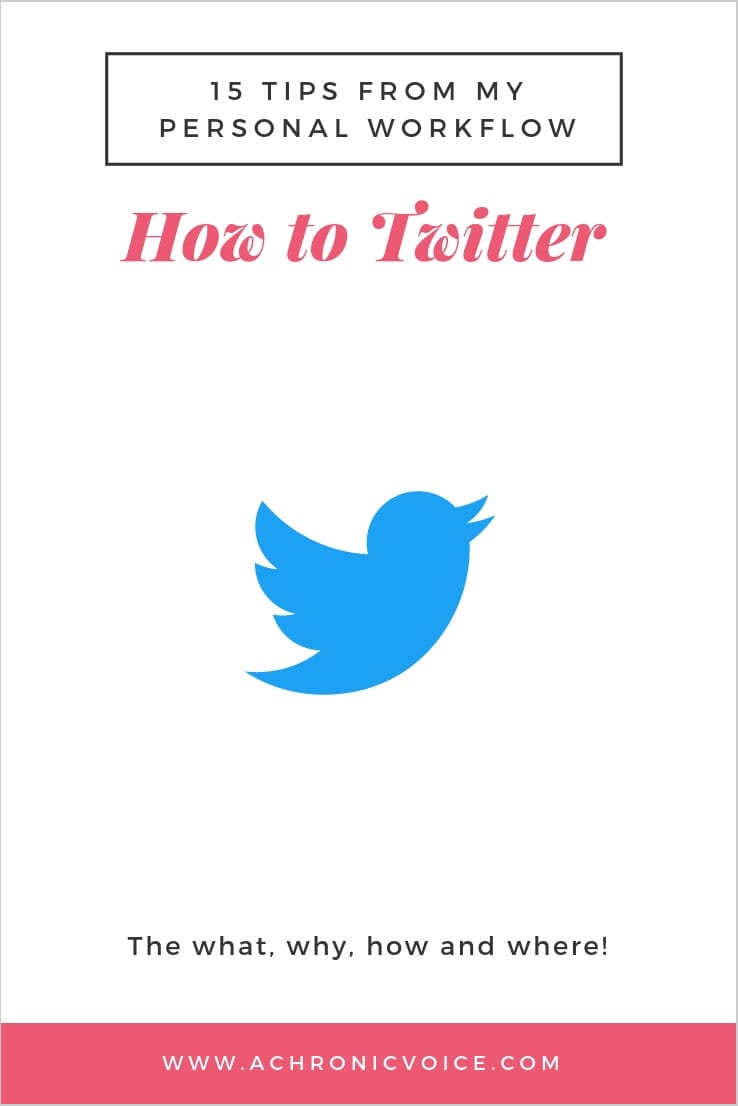

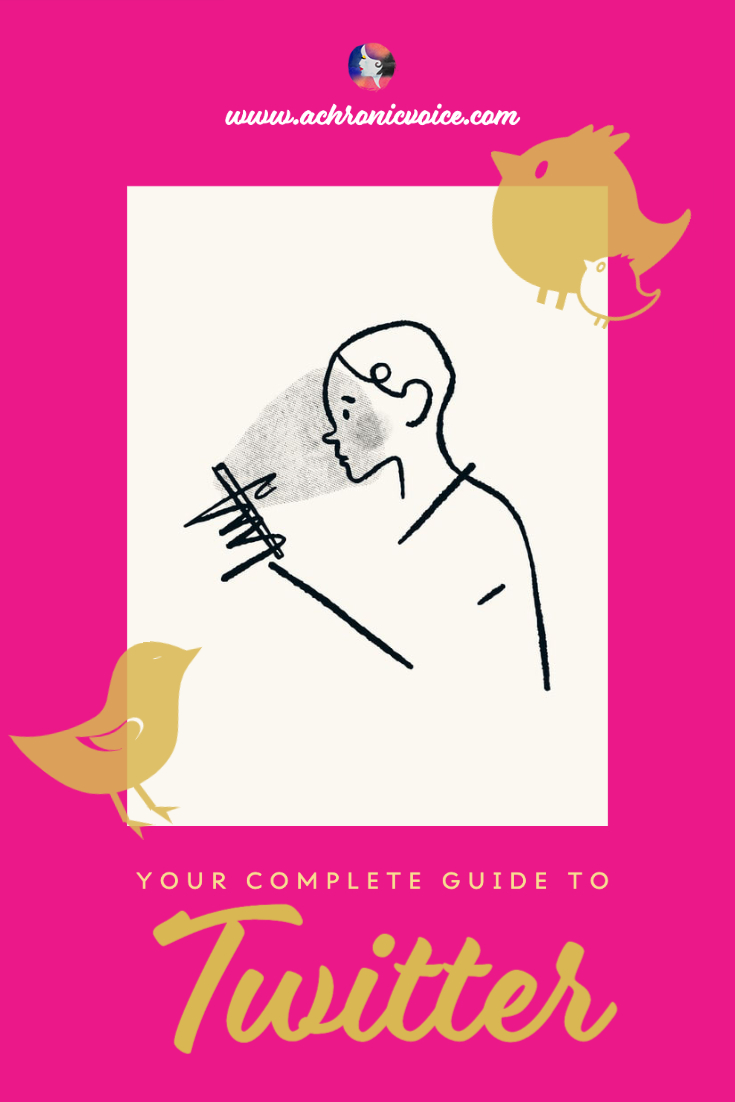


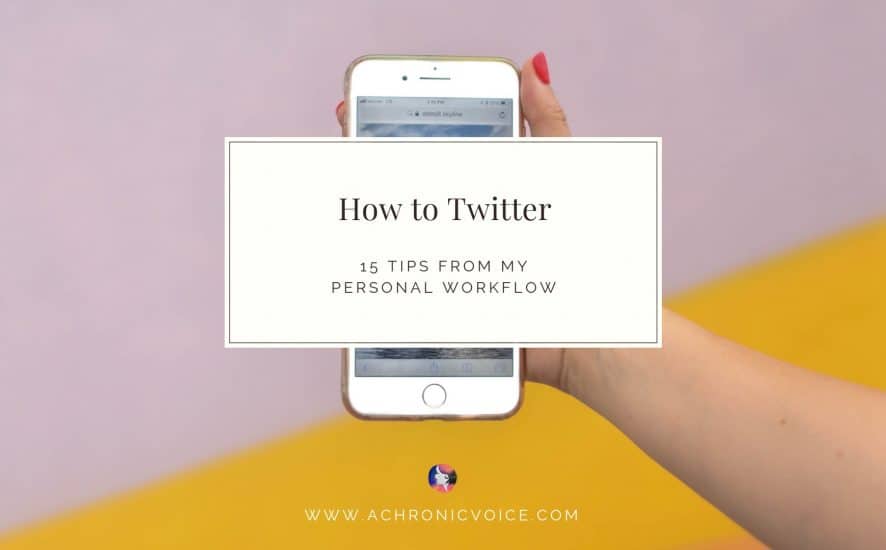
Thank you so much for this post! I’ve definitely been slacking a lot on Twitter and wondering why my engagement is so low. I’m clearly doing a lot wrong LOL excited to implement these tips!!
Hi Tsvetty! There’s no right or wrong per se! But definitely some things could use a boost. Good luck on your Twitter and social media journey!
Hi Friend
This is so helpful and a bit overwhelming, I will reread this many times. I’m terrible on Twitter and am amazed at how many followers I have. I did go and add hashtags to my profile right away. I’m not blogging for a living so some of this is a lot of work for what I’m trying to do. I do think it’s time I get more serious about how to use hashtags and start with that step first. Then I can move onto more steps.
Hi Melinda, feel free to reach out anytime. Take one thing at a time and most importantly, you need to enjoy the process. Personally for me I love Twitter best, but for you, you might find more affinity with another social media platform. So focus your energy where you most enjoy it to grow 🙂
I’m going to try out InstaPaper. I always like the things that I read but if I don’t get to them I think that I can always go back to my liked list on Twitter. However, I rarely do. I like that this will collect things I can read in a newspaper type format on my tablet (where I also read my digital books).
I also want to try Buffer, but it sounds like they’ve changed so I’d have to pay for it to be of benefit, is that right?
Hi Katie! I’m not sure if they’ve changed the pricing, they haven’t updated me or anything. But yes, Instapaper is really fab and I can spend hours reading articles for sharing from there 🙂 Sadly they had to revert to a paid vs unpaid version so the highlighting is limited (one of the features I use a lot).
This is my next venture. I haven’t used a scheduler yet. Do you still think Buffer is the way to go?
I like Buffer because it’s fairly cheap (USD15 for an upgrade to Pro if you need 8 accounts and more posts to schedule, which I do maximise 🙂 ), the interface is good (I do most of my scheduling on mobile even), and the customer service is top notch. I haven’t tried other schedulers (paid versions) as they lean towards more pricey, or I don’t like the interface of some free ones. They have a 14 day free trial so you can give it a go if you like! 😀
Thanks Sheryl, this was really interesting and I learnt a lot! I don’t think I use Twitter all that well so your tips were very handy. I’ve pinned this post and will refer back to it from time to time. I’ve always admired the way you take a quote from a post and use that in your tweet, so now I know how you do it. I worry at times about thanking people for retweets as it seems a bit like clogging up the feed and i feel a bit pesky, but I can see how it’s the polite thing to do. I will give it a try. Thanks again for sharing your knowledge.
Hi Debbie, you’re most welcome! And I hear where you’re coming from. Truth is, it DOES get a bit pesky and clogs up the feed a little, hence why I said in the post it’s a bit like ‘picking your own poison’ :p Can’t please everyone and some people do get annoyed with me, but over all, I think spreading some love around makes me happier in the long run 🙂 All the best!
You really are the queen of Twitter Sheryl! I have already picked up so many tips from you and think I might try your scheduler – currently use Tweetdeck and Tailwind. Really useful post, Claire x
Aww…you’re always so kind, Claire 😉 I love Buffer. Tweetdeck didn’t work out for me. Tailwind is great for pins! 🙂 x
I will def give Buffer a go as I’m not keen on Tweetdeck! Sheryl, I have shared this on PainPalsBlog reg feature Monday Magic – Inspiring Blogs for You, Claire x
Let me know how it goes and if you need any help! 🙂 And thank you so much, you are always so kind 🙂
thank you. Twitter has been something I have had forever but never really got into. This was great.
Hi Brenda, you’re welcome! I hope these tips help you in some way, but of course, there are no ‘rules’ and you can do you, too! 🙂
Thankyou Sheryl for your very helpful and interesting post. I will often try and use relevant hash tags that are trending.. it is amazing though how many tweets you miss that you might like to have seen. Yesterday I was looking at my spam email from Twitter that mentioned a tweet i had not seen. It was one I would have liked to have seen and I emailed the person straight away. So often I think our tweets get lost in Twitter world, not seen and maybe not read by those who would be interested.
Thanks for the feedback, Marian! Yes, Twitter goes so quickly…so many moving parts, that it can be hard as well to get your message across or to receive a good one 🙂
Wow, Sheryl, this is such a helpful post! Thank you for these great tips, and for taking the time to write this. As you can probably tell, I love Twitter too! ☺️ I’m probably what you’d call an “intuitive tweeter” though! By this I mean I don’t really follow any real strategies, but just seem to do what feels right!! However, reading your article, I realise there’s a lot I actually do do, but a lot still to learn ? I must look into instapaper (sounds fab) and scheduling apps. Also made my think about my thumbnail… hmmm! I also need to keep a track of followers/unfollowers. I do this on Instagram (drives me crazy when someone follows me only to unfollow once I follow them!!!), but not on Twitter for some reason. Anyway, I’m waffling but just wanted to say thanks for this great content ? xx By the way, I’m not sure why sometimes it picks up who I am on here & other times it doesn’t?!!
Hi Emma! Haha I get what you mean by being intuitive about it 🙂 I think that happens when you enjoy something, and like you said, you enjoy Twitter 🙂 Yes I don’t get why they’d unfollow right after…what’s the point, right?!
If you like reading blog posts or read a lot of them especially on your phone, I’d definitely recommend Instapaper 🙂 I was on the paid version once, then they had enough funding and decided to make it free for all – how rare is that 😉
And that’s weird…I’ll add you to the white list to be sure! My spam catcher is a bit aggressive, but still quite a bit of spam bypasses it in chunks from time to time. Sending hugs and hope you have a good day!
This is a great post, thank you for sharing some useful tips. I am terrible at keeping on top on my social media and sharing my own posts.
Hi Gemma, thanks for taking the time to read it! Took me a long time to write this one haha (seven drafts). I like planning stuff so maybe it makes it a bit easier in that regard. And Buffer helps a lot as well 🙂 Good luck! 😀
Sheryl, thank you so much for this post! As you know, I’ve only joined Twitter recently, and I have no idea what I’m doing. I really enjoy seeing what everyone is up to and being able to share others’ articles, but I haven’t known how many times I should share either my posts or others, etc. This article is extremely helpful, and I’m ready to get to work putting all your fabulous tips to use. Thanks again!
You’re most welcome, Terri! These tips aren’t hard and fast rules (some others may even disagree with certain things), so just take what you need 🙂 Hopefully by using the tools we have properly, our efforts for awareness will do double duty! 🙂